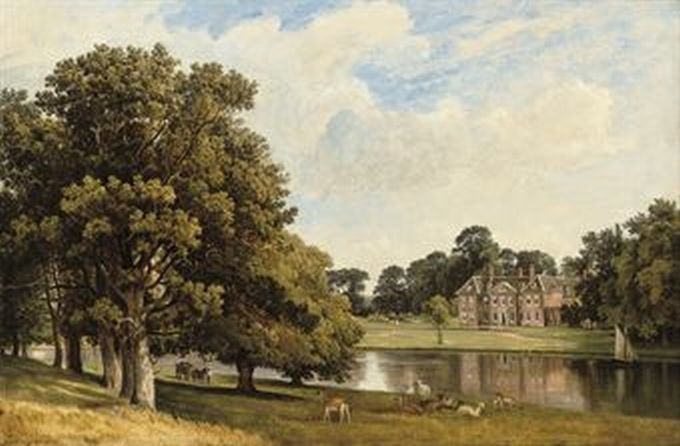Editorial Review: “Easter at Netherfield” Author: Gill Mather Book 3: The Elizabeth Bennet Series: A Pride and Prejudice Variation
“Elizabeth found that all of her anger had suddenly abandoned her. She studied her hands as she turned them in her lap. The subject embarrassed her, she felt like a child who had been caught out. But really why should she? If anyone should feel ashamed, it should be him. Should she evade answering this precise question yet again? Should she respond indignantly that he had created this problem, that he could not now twist everything to make it appear that she was somehow at fault?
“Easter at Netherfield” is Book Three in Gill Mather’s Elizabeth Bennet series. It can also be read as a standalone novel, as this reviewer has very happily done. The great advantage of reading a Pride and Prejudice variation is the longed-for opportunity to follow Elizabeth’s married life with Darcy on the written page, where situations and conversations continue to develop and provide more insight into Austen’s legendary characters. Who among us has not secretly wished that Austen had added just a few more chapters to her iconic book? Mather’s writing is detailed, and the scenes she has created allow the reader to see more deeply into the emotions and personalities of all of the familiar characters, particularly Elizabeth and Darcy.
Elizabeth and Darcy are newly-weds, and Elizabeth has recently confirmed she is expecting a baby. But a situation from Darcy’s past causes tension between Elizabeth and Darcy, and Darcy’s business hopes mean that he must also focus on those plans. There is still much love between them, but absence and assumption cause misunderstandings (in ways that readers of Pride and Prejudice may be familiar with!). An Easter gathering acts a catalyst and wider family drama adds to Elizabeth’s concerns. There are appearances by Caroline Bingley, and dare this reviewer say it, the first traces of sympathy may be evoked in the reader for Elizabeth’s (and Jane’s) nemesis. It is also a highlight to read of Georgiana again, and the younger Bennet sisters who are finding their own paths. For those readers who against their better judgment require an update on Mr Collins (he of the ill-fated proposal), he is now a doting father.
As with any new book that expands on characters already so firmly set in every reader’s mind, there may well be differing views as to the faithfulness of Mather’s interpretation and development of personality and the continuation of the storyline – but that is a subjective decision for every reader. At times Elizabeth appears reticent and also petulant; these were not traits that were readily noticeable in the original work. At other times her depiction as a newly-wed, settling into life with her husband and managing her ongoing family concerns is highly compelling. There is also an extensive focus on Darcy’s business plans and the related technical details. Mather has clearly undertaken in-depth research to ensure the accuracy of the storyline she has chosen. This does provide the reader with a wider view of Elizabeth’s times, but also takes the reader away from the social intrigues and family interactions that were the hallmark of Austen’s book.
“Easter at Netherfield” contains a range of conversations, and Mather uses this dialogue to progress the storyline. This can mean that some of the dialogue tends towards exposition, but other exchanges contain wonderful wit and sharp observation, in the best traditions of Austen:
“Caroline, if I could speak a little more plainly, your conduct towards me and my family demonstrated very clearly that you held us in low esteem. Some of the things you said were scornful. It is a form of cruelty, and, I would submit, not an obviously attractive feature. A man observing you might well be repelled. Of course, I have not made a close study of you. I have had no cause to. But you may have similarly treated others and therefore unwittingly portrayed yourself as unkind or appeared so in the eyes of others.”
The character arcs within the novel are authentic, and the storyline is well-paced. Pride and Prejudice has a wide cast of characters and Mather introduces more, yet the relationships and connections between them are clearly apparent to the reader and skilfully woven together by the author. There is a happy ending, and also an intriguing bonus chapter which demonstrates that Book Four will be another great read for those of us who love to travel to Austen-land!
“Easter at Netherfield” by Gill Mather is a stand-out for this reviewer as an addition to the genre of Pride and Prejudice variations/continuations. Mather has shown Elizabeth and Darcy in the early months of their marriage, in highly relatable circumstances. They are preparing for parenthood, with both business and family concerns. On top of that, Darcy is grappling with an issue from his past and his inability to confide properly in Elizabeth leads to misunderstanding and further miscommunication. It is a daunting task to delve into one of English literature’s legendary marriages and Mather succeeds in this with aplomb, showing how even two people so much in love still have lessons to learn. And now to Georgiana and that bonus chapter…
*****
“Easter at Netherfield” by Gill Mather receives 4 stars from The Historical Fiction Company
*****
The attached image is of Chilston Park in Kent. Netherfield might have looked like this. The link to this review is:
https://www.thehistoricalfictioncompany.com/post/darcy-s-dice-with-fate-an-editorial-review-of-easter-at-netherfield


Recent Comments